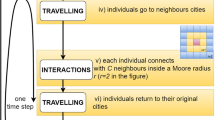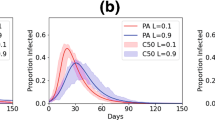Abstract
A stochastic two-state epidemiological cellular automaton model is studied, where sites move between susceptible and infected states. Each time step has two phases: an infectious phase, followed by a treatment or recovery phase. During the infectious phase, each infected site stochastically infects its susceptible neighbors. During the recovery phase, contiguous blocks of sites are reset to the susceptible state, representing spatially clustered treatment or recovery. The spatially extended recovery events are coordinated events over groups of cells larger than standard local neighborhoods typically used in cellular automata models. This model, which exhibits complex spatial dynamics, is investigated using simulations, mean field approximations, and local structure theory, also known as pair approximation in the ecological literature. The spatial scale and geometry of recovery events affects the equilibrium distribution of the model, even when the probability of block recovery events is rescaled to maintain a constant per-site recovery probability per time step. Spatially clustered treatments reduce the equilibrium proportion of infected invididuals, compared to spatially more evenly distributed treatment efforts.
Chapter PDF
Similar content being viewed by others
Keywords
These keywords were added by machine and not by the authors. This process is experimental and the keywords may be updated as the learning algorithm improves.
References
Hiebeler, D.: Spatially correlated disturbances in a locally dispersing population model. Journal of Theoretical Biology 232, 143–149 (2005)
Caswell, H., Etter, R.J.: Ecological interactions in patchy environments: From patch occupancy models to cellular automata. In: Levin, S., Powell, T., Steele, J. (eds.) Patch Dynamics, pp. 93–109. Springer, Heidelberg (1993)
Hiebeler, D.: Stochastic spatial models: From simulations to mean field and local structure approximations. Journal of Theoretical Biology 187, 307–319 (1997)
Gutowitz, H.A., Victor, J.D.: Local structure theory in more than one dimension. Complex Systems 1, 57–68 (1987)
Wilbur, W.J., Lipman, D.J., Shamma, S.A.: On the prediction of local patterns in cellular automata. Physica D 19, 397–410 (1986)
Levin, S.A., Durrett, R.: From individuals to epidemics. Philosophical Transactions: Biological Sciences 351, 1615–1621 (1996)
Filipe, J., Gibson, G.: Comparing approximations to spatio-temporal models for epidemics with local spread. Bulletin of Mathematical Biology 63, 603–624 (2001)
Gutowitz, H.A., Victor, J.D., Knight, B.W.: Local structure theory for cellular automata. Physica D 28, 18–48 (1987)
Feldman, D.P., Crutchfield, J.P.: Structural information in two-dimensional patterns: Entropy convergence and excess entropy. Physical Review E 67 (2003)
Author information
Authors and Affiliations
Editor information
Editors and Affiliations
Rights and permissions
Copyright information
© 2005 Springer-Verlag Berlin Heidelberg
About this paper
Cite this paper
Hiebeler, D. (2005). A Cellular Automaton SIS Epidemiological Model with Spatially Clustered Recoveries. In: Sunderam, V.S., van Albada, G.D., Sloot, P.M.A., Dongarra, J.J. (eds) Computational Science – ICCS 2005. ICCS 2005. Lecture Notes in Computer Science, vol 3515. Springer, Berlin, Heidelberg. https://doi.org/10.1007/11428848_48
Download citation
DOI: https://doi.org/10.1007/11428848_48
Publisher Name: Springer, Berlin, Heidelberg
Print ISBN: 978-3-540-26043-1
Online ISBN: 978-3-540-32114-9
eBook Packages: Computer ScienceComputer Science (R0)




